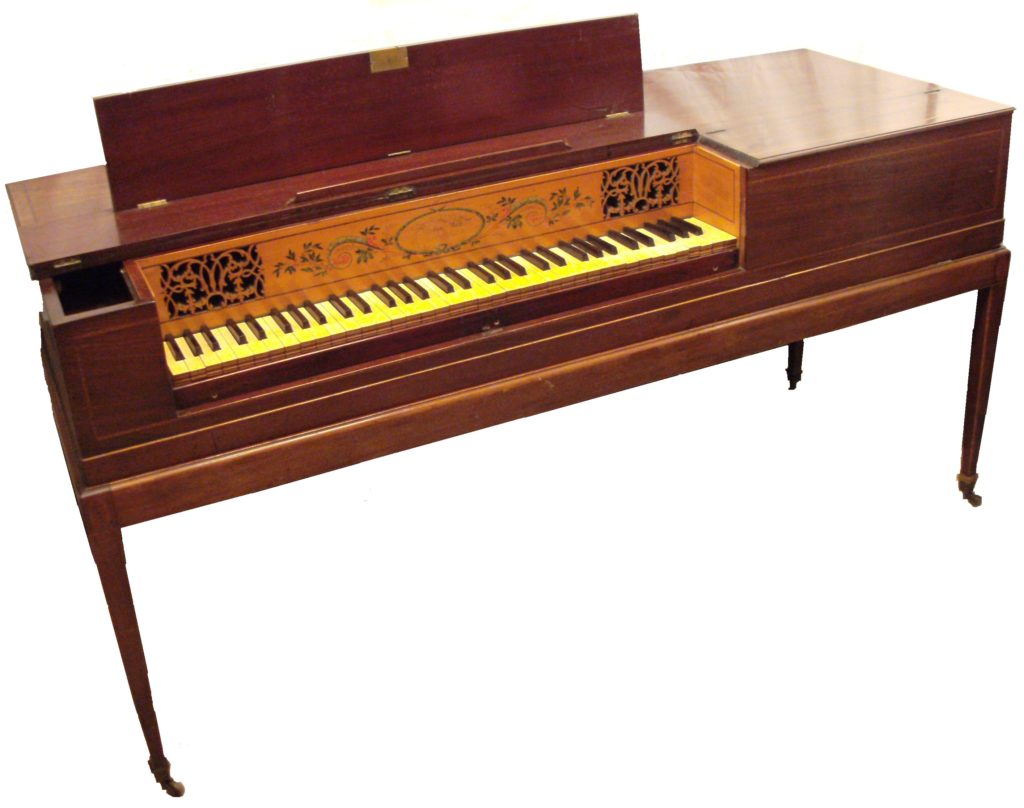William Rolfe 1803
Description

| Date: | 1803 |
| Origin: | London |
| Serialnumber: | 4490 |
This square piano comes from the workshop of William Rolfe and shows an instrument of classical elegance, as it was favoured by the English upper class in the late 18th to the early 19th century. Special features of these instruments are the richly decorated nameboards with flowers, tendrils and fruits. They are closely similar to the ones made by Muzio Clementi (see also the pianoforte by Muzio Clementi from the same production year 1803 in the Eric Feller Collection – click here).
The case is made of mahogany with surrounding and multi-colour ribbon inlays of different woods. The instrument rests on a French stand with brass castors. The keyboard is made from ivory and ebony, it has a wooden pedal for controlling the dampers and is double strung. Garlands of flowers, tendrils and fruits are painted on the nameboard. In a cartouche is the slightly faded signature:
“William Rolfe
No. 112 Cheapside London”
The stamped serial number reads 4490 on the wrestplank. Furthermore the instrument has a double action with leathered hammers and single dampers. The compass of the keyboard is 5 ½ octaves (FF – c4).
The dating (if none is found) of many instruments is often difficult and is then based only on the structural characteristics and on the basis of the little information the signature on the nameboard can give. Unfortunately no documents about the production by Rolfe are known, so dating is difficult. For this instrument however the exact production date could be determined, since the instrument with the serial number 4480 (thus only 10 serial numbers earlier – a combination instrument from square piano and organ) is signed with the year 1803. It is located in the Colonial Williamsburg Foundation in Williamsburg / USA.
William Rolfe worked as a piano maker from 1785 to about 1828. His exact dates of birth and death are not known yet. From 1785 he worked with Samuel Davis and the company was run under the name Rolfe & Davis. In 1797 both developed a patent for a “Turkish-Music-Stop” with cymbals and drums. According to R. Harding, this patent is the oldest testimony to such a change in the form of a janissary stop, which was very popular in the 1820s (especially by Viennese instruments) and then disappeared very quickly.
At the same time William Rolfe worked as an instrument maker and music publisher and was a partner of Thomas Culliford with whom he produced instruments for the company Longman & Broderip. He also sold his instruments under his name. After the bankruptcy of Longman & Broderip in 1796, he worked only under his name.
In 1807, his two sons Nicholas and Thomas became partners in the father’s company. From 1814, the company was renamed to William Rolfe & Sons and there were additional premises in the London Wall Street no. 32 added. The main address was since its founding in Cheapside 112. From about 1820 instruments were made under the name William Rolfe and Compy. The company existed until 1889.
Other preserved instruments by William Rolfe:
- 1803 square piano & organ (No.4480) – Colonial Williamsburg Foundation, Williamsburg / USA
- 1803 square piano (No. 4481) – Cambridge University, Cambridge England
| Length: | 169 cm |
| Width: | 60 cm |
| Height: | 27 cm |
| Circumference: | 5 ½ octaves (FF – c4) |
| Mechanics: | double action |
| Pedals: | 1 pedal - dampers |
| Signature: |
"William Rolfe No. 112 Cheapside London" |

